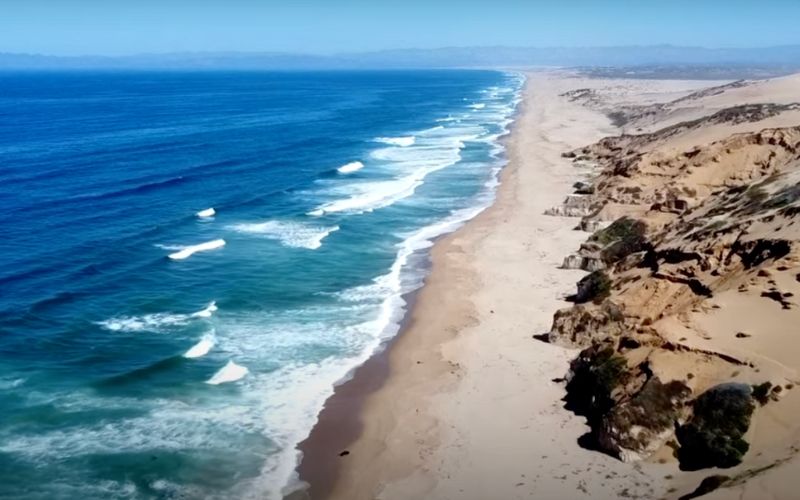
- Details
- By Kaili Berg
In a historic first, last week, the homelands and ocean waters of the Chumash Peoples on the central California coast were designated a national marine sanctuary.
Chumash Heritage National Marine Sanctuary is the first Indigenous-nominated national marine sanctuary. The designation marks the culmination of decades of advocacy led by the Northern Chumash Tribal Council (NCTC).
The sanctuary is under a required 45-day review period by Congress and the State of California, which began October 16. It's expected to be finalized by December 2024.
The journey toward the designation of the Chumash Heritage National Marine Sanctuary began nearly 45 years ago when environmentalists, Indigenous leaders, and community advocates first rallied to protect California’s Central Coast from industrial development, including offshore oil drilling.
Since the 1980s, the Chumash people, along with various environmental organizations, recognized the vulnerability of the region’s waters to ecological degradation and the urgent need to preserve its marine biodiversity and cultural heritage.
In 2015, Chief Fred Collins, the late Chair of the Northern Chumash Tribal Council, officially nominated the CHNMS to NOAA, a move that reignited momentum for the effort. Collins’ vision was to protect not just the ocean’s biodiversity but also the submerged sacred Chumash sites and ancestral waters that have been central to the Chumash way of life for over 10,000 years.
Before his passing in 2021, Collins reflected on the significance of the sanctuary’s creation, stating: “Grandmother Ocean has been providing life to the Chumash Peoples for over ten thousand years; now is the time for all communities to work together and assist her in rebuilding her Vibrant Thrivability for all future generations.”
The campaign to designate the CHNMS has been marked by years of advocacy, coalition-building, and legal efforts. The Northern Chumash Tribal Council worked closely with local environmental groups, conservationists, and marine scientists to highlight the region’s unique ecological and cultural importance.
This grassroots movement saw the involvement of diverse stakeholders, including fishermen, Indigenous communities, and environmentalists who shared a common goal to protect this ecologically rich area from industrial encroachment.
Over the years, the coalition has engaged in countless public meetings, lobbying efforts, and community education initiatives to bring national attention to the cause. Volunteers tabled at farmers’ markets, circulated petitions, and spoke before local governments to raise awareness about the sanctuary’s potential to protect marine life, address climate change, and honor Chumash cultural sites.
The CHNMS is not only the first Indigenous-nominated national marine sanctuary but also one of the most ecologically significant areas in the United States. When finalized, it will be the third-largest national marine sanctuary, spanning over 7,000 square miles of ocean off California’s Central Coast, an area recognized as a globally important ecological transition zone.
The region is home to diverse wildlife, including at-risk species such as the southern sea otter, leatherback sea turtles, snowy plovers, and blue whales.
The sanctuary will safeguard key marine ecosystems such as kelp forests, underwater canyons, and seamounts, all of which play crucial roles in carbon storage and climate regulation. It will also ban new oil drilling, protecting the waters from further industrial harm.
For the Chumash people, this designation is deeply personal. Submerged within the sanctuary’s boundaries are ancient Chumash village sites that hold great spiritual and historical significance. Protecting these underwater archaeological sites ensures that Chumash ancestors’ resting places remain undisturbed for generations to come.
“Each step we’ve taken in this determined campaign to fulfill the dream of my late father, Chief Fred Collins, has been sweeter and more poignant,” Violet Sage Walker, Chairwoman of Northern Chumash Tribal Council, said in a press release. “I am overwhelmed with gratitude for all who have helped bring to life the vision of a Chumash Heritage National Marine Sanctuary. We are almost there and the significance of our collective effort will make history, begin to heal centuries of wounds to our People, and bring all of us closer together.”
Once finalized in December 2024, the CHNMS will nearly double the amount of protected coastline along the Central Coast. It will promote climate resilience and serve as a model for future Indigenous-nominated and co-stewarded marine sanctuaries.
“Their efforts to designate the Chumash Heritage National Marine Sanctuary is a gift to us all. It’s a celebration of a place that has always had a sanctuary in their hearts, and now they are sharing that with everyone,” Dr. Steve Palumbi from Stanford University, who has collaborated with the Northern Chumash Tribal Council, said in a press release.
More Stories Like This
Southern Sierra Miwuk Nation Gets 900-Acres ofLand BackChilkat Indian Village Tells New Palmer Mine Owners They Are “Not Welcome” in Chilkat Valley
Tribes, Coastal Group Ask Army Corps to Revoke Permit for Texas Export Terminal
Michigan Tribes Tell Supreme Court: Don’t Bail Out Enbridge
Alaskans Raise More Than $1 Million For Communities Devastated by Typhoon Halong
Help us defend tribal sovereignty.
At Native News Online, our mission is rooted in telling the stories that strengthen sovereignty and uplift Indigenous voices — not just at year’s end, but every single day.
Because of your generosity last year, we were able to keep our reporters on the ground in tribal communities, at national gatherings and in the halls of Congress — covering the issues that matter most to Indian Country: sovereignty, culture, education, health and economic opportunity.
That support sustained us through a tough year in 2025. Now, as we look to the year ahead, we need your help right now to ensure warrior journalism remains strong — reporting that defends tribal sovereignty, amplifies Native truth, and holds power accountable.
 The stakes couldn't be higher. Your support keeps Native voices heard, Native stories told and Native sovereignty defended.
The stakes couldn't be higher. Your support keeps Native voices heard, Native stories told and Native sovereignty defended.
Stand with Warrior Journalism today.
Levi Rickert (Potawatomi), Editor & Publisher


